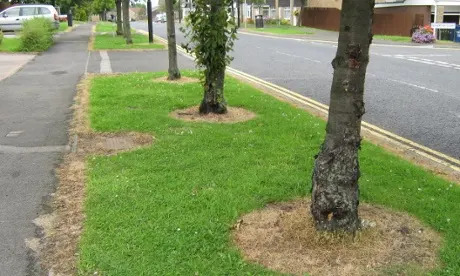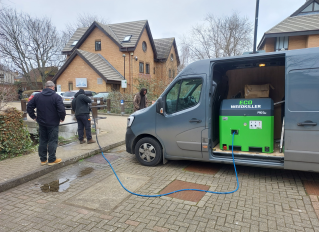Is Zero Chemicals the Solution?
I have been asked to be on a Panel at SAGE discussing the topic "Is Zero Chemicals the Solution?" Here are some initial thoughts.
What do we mean by the question - Is Zero Chemicals the Solution?
There are quite a few chemicals that can be used for weed management.
However, the most common substance in weed management by a country mile is Glyphosate.
In a recent Local Authority Survey in Scotland, Glyphosate "accounted for 99 per cent of the total herbicide active ingredient weight applied".
So what we are really asking is; should we stop using Glyphosate to manage weeds, and can it be done another way with a budget and results we are happy to accept.
My position is that we currently use Glyphosate far too much.
I am against it's over use, because our reliance on Glyphosate to deliver weed control has led to poor surface management and reduced habitats for wildlife and pollinators, as well as an excellerated deteriation of our urban infrastructure. We paper over the cracks in our pavement with it, scortch the earth around trees and obstacles with it, use it very ineffectually for chemical edging, or simply obliterating all nature in the middle of our highways. That should stop.
Every time we spray and neglect basic maintenance such as sweeping, we add to the future soil build up and weed load on our surfaces. This is unsustainable long term and makes the problem harder to deal with each year that goes by.

The picture shows the A1(m) after miles of blanket chemical treatment to the edges and central reservation.
The main objection I hear to banning the use of Glyphosate, besides budget is that we need it for Invasive Species.
The same Local Authority Survey in Scotland suggested that this accounts for around 2% of it's overall use.
Perhaps that's ok, I could probably sleep more soundly at night if we were only using 2% of the Glyphosate we do now.
Maybe it's even ok to spot spray with Glyphosate in certain situations. I'm not trying to rely on any claims of it being unsafe if used as directed. There seem to be a lot of people weighing in on both sides of the safety debate and I'm not qualified to give you an answer. However, spraying a strip all the way along a highway, or footpath to chemically edge it is not responsible spraying in my book and I think this has to stop. It's a terrible over use of chemical, which is contributing to a large and widely acknowledged reduction in habitats for polinators. Beyond this, it compounds many of the problems on our hard surfaces, such as poor drainage, reduced access and increased weed load in the future. We should not carry on spraying as we do. Nor should we simply use foam, hot air or hot water to blanket treat the same areas either. It results in the same problems with the loss of habitat, poor drainage and reduced access.
So what should we be focusing our weed management efforts on?
We should be working with Nature Based Solutions to achieve a balance between the encouragement of bio-diversity and the protection of our Urban Infrastructure.
This means we need to remove the encroaching soil mechanically to allow our roads and paths to do what they should be doing -
Allowing access for traffic, pedestrians and wheelchairs, and allowing water to run away into drains that aren't clogged up with soil and weeds.
There are tools to allow this to be done quickly and cheaply.
After which, we can spot treat the rest effectively with a variety of tools, which might include Glyphosate, but could also include hot air, hot water, electricution, steam, vinegar, and a host of other solutions. The choice of which will depend on the type of surface, the types of plant being targeted, the weather, proximity to water courses and a host of other factors.

This picture shows the completely unnecessary blanket application of chemical for edging of paths and the base of trees, which should be dealt with another way.
Around trees, under hedges and other obstacles there are vast options for desirable plants we could put in the area, which might be easily managed and suitable, rather than spraying back to bare soil. The RHS website lists over 100 different species that may be suitable in different conditions under trees.
https://www.rhs.org.uk/plants/for-places/under-trees
Using these plants will avoid weeds taking hold at the base of a tree, as the coverage will often suppress other plants, and provide a much needed habitats for polinators.
We must stop blanket treating weeds and do the preventative work that allows spot treatment
We are at the stage where, because people are trying to continue blanket treating weeds, having forsaken every other tool at their disposal, they are left with no economical choice but to spray. When we come to replace chemicals, but try to keep these frankly horrid work practices - we find that the alternatives will be expensive and labour intensive to use.
When people currently say they are spot spraying; Unfortunately, what they typically mean is that they are using technology that is capable of spot spraying. There are machines capable of pinpointing weeds and applying a targeted application of chemical to the plant, but when the vegetation coverage is 30% or higher under the machine, then the reality is that there are no distinct, individual weeds to spot treat. The machine is simply doing the equivalent of a blanket spray due to the density of weed coverage. The next time they spray, without removing the soil - the coverage will be worse still.
Making Thermal Weed Management technologies more effective and sustainable
I could wax lyrical about the effectiveness of the alternatives which already use some fantastic technology to deliver effective control of weeds. But it is almost pointless adopting new technology without also adopting new working practices. If we thought about grounds maintenance a bit more creatively and did some preventative work, instead of simply reaching for the bottle we could ensure that we only need spot treatments. Once this has been achieved then using alternative methods in many cases becomes not simply more viable, but sensible.
Thermal methods can be used in wet weather, so we can ensure that treatment is applied as early as possible. This significantly reduces the energy required to carry out the treatments, as you are only having to apply enough hot water or air to treat a smaller plant, rather than a larger one. It also allows us to ensure we treat well before weeds go to seed - reducing the seed bank for future treatments, and allowing us to actually get on top of the problems, rather than constantly playing catch up.

Eco Weedkiller Hot Water Technology being used safely by a water course.
Will Glyphosate be banned or restricted in the UK?
It's not important to my argument whether Glyphosate is banned or not. Either way, we still need to change our working practices.
However, it would probably be remiss of me not to at least address this as part of the question..
The safety issue is probably the main one that will determine whether Glyphosate is actually banned or not. In July of 2021, agrochemical giant Bayer announced that the company would stop selling their popular Weed Killer Roundup to residential consumers beginning in 2023. The court cases over Non-Hogkin's Lymphoma and other Cancers might have had something to do with this. The company has set aside around 10 Billion USD to settle the claims. As of April, Bayer counted 52,500 total suits, while the 125,000 number represents all cases that include those being held in abeyance and haven’t been filed or served. The settlement, which hasn’t been officially signed and approved by a judge, will allocate $8 billion to resolve current cases, while another $2 billion could be saved for future suits, according to the newswire.
The license for Glyphosate has currently been extended until 2025 in the UK. However, this may become irrelevant for amenity professionals due to other guidance and legislation. Defra has been working on a National Action Plan for the sustainable use of pesticides, which seems likely to be published this year. We have already seen in the Environmental improvement plan published in January that they aim to reduce pesticide use to 50% of current levels by 2030. The National Action Plan will lay out how this is to be achieved. Having listened to many of the discussions around the formation of this plan, we can be sure that Defra are promoting Integrated Weed Management as the way of doing this. The plan will likely involve restrictions to where Glyphosate can be applied and is certainly being put forward with the aim of reducing Glyphosate use.
Whether Glyphosate can be replaced effectively in amenity areas will not depend on some new awesome technology coming out, but on changing our working practices so that any technology becomes more effective and sustainable to use.
To find out more about weed prevention and Integrated Weed Management check out this link
The YouTube video for the Eco WeedKiller Pro3 and Pro10 can be found here!
No comments yet. Login to start a new discussion Start a new discussion